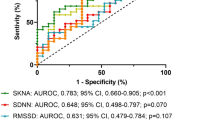Abstract
Introduction and hypothesis
Our objective was to compare autonomic nervous system function between women with an overactive bladder (OAB) and control participants during regulated bladder filling.
Methods
Twenty-four women, nine with OAB and 15 without (control), were instructed to drink 1.5 l of water at a rate of 250 ml every 5 min during continuous electrocardiogram (ECG) monitoring. Participants were asked to indicate first sensations of filling (FSF), first desire to void (FDV), strong desire to void (SDV), and maximal bladder capacity (MC). ECG signals were used to assess heart rate variability, which were analyzed in time and frequency domains using the fast Fourier transform. The low-frequency (LF)and high-frequency (HF) spectral bands were used to asses sympathetic and parasympathetic pathways, respectively.
Results
During the bladder-filling phase, women with OAB had significantly lower LF values (at the MC phase 5.4 ± 1.4 ms2/Hz vs. 6.4± 0.6 ms2/Hz in the control group, p = 0.02). In the control group, LF increased continuously, whereas in the OAB group, LF increased until the sensation of SDV and then abruptly decreased to baseline values. MC was lower in women with OAB (372 ± 153 ml vs. 592 ± 298 ml, p < 0.05, respectively).
Conclusions
Reduced sympathetic tone in women with OAB may explain their attainment of lower volumes of MC and their sensation of urgency. The rapid decrease in sympathetic neural activity that accompanies the sensation of an SDV may be related to the pathophysiology of the urgency symptom in these women.

Similar content being viewed by others
References
Haylen BT, de Ridder D, Freeman RM et al (2010) An International Urogynecological Association (IUGA)/International Continence Society (ICS) joint report on the terminology for female pelvic floor dysfunction. Int Urogynecol J Pelvic Floor Dysfunct 21:5–26
Stewart WF, Corey R, Herzog AR et al (2001) Prevalence of overactive bladder in women: results from the NOBLE program. Int Urogynecol J Pelvic Floor Dysfunct 12(3):S66
Hu TW, Wanger TH, Bentkover JD, LeBlanc K et al (2003) Estimated economic costs of overactive bladder in the United States. Urology 61(6):1123–8
Chu FM, Dmochowski R (2006) Pathophysiology of overactive bladder. Am J Med 119(3 Suppl 1):3–8, Review
Yoshida M, Masunaga K, Nagata T, Yono M, Homma Y (2010) The forefront for novel therapeutic agents based on the pathophysiology of lower urinary tract dysfunction: pathophysiology and pharmacotherapy of overactive bladder. J Pharmacol Sci 112:128–134
Pomeranz M, Macaulay RJB, Caudill MA et al (1985) Assessment of autonomic function in humans by heart rate spectral analysis. Am J Physiol 248:H151–H153
Koizumi K, Terui N, Kollai M (1985) Effect of cardiac vagal and sympathetic nerve activity on heart rate in rhythmic fluctuations. J Auton Nerv Syst 12:251–9
Task Force of the European Society of Cardiology and the North American Society of Pacing and Electrophysiology (1996) Heart rate variability. Standards of measurement, physiological interpretation, and clinical use. Eur Hear J 17:354–81
Choi JB, Kim YB, Kim BT, Kim YS (2005) Analysis of heart rate variability in female patients with overactive bladder. Urology 65:1109–1112
Liao WC, Jaw FS (2010) A noninvasive evaluation of autonomic nervous system dysfunction in women with an overactive bladder. Int J Gynaecol Obstet 110:12–17
Mehnert U, Knapp PA, Mueller N, Reitz A, Schurch B (2008) Heart rate variability: An objective measure of autonomic activity and bladder sensations during urodynamics. Neurourol Urodyn 28:313–319
Im HW, Kim MD, Kim JC, Choi JB (2010) Autonomous nervous system activity in women with detrusor overactivity. Korean J Urol 51:183–186
Coyne K, Revicki D, Hunt T et al (2002) Psychometric validation of an overactive bladder symptom and health-related quality of life questionnaire: the OAB-q. Qual Life Res 11:563–574
Reitz A, Schmid DM, Curt A, Knapp PA, Jensen K, Schurch B (2003) Electrophysiological assessment of sensations arising from the bladder: are there objective criteria for subjective perceptions? J Urol 169:190–194
Braverman AS, Luthin GR, Ruggieri MR (1998) M2 muscarinic receptor contributes to contraction of the denervated rat urinary bladder. Am J Physiol 275:R1654–60
Wein AJ (2001) Pharmacological agents for the treatment of urinary incontinence due to overactive bladder. Expert Opin Investig Drugs 10:65–83
Chapple CR (2000) Muscarinic receptor antagonists in the treatment of overactive bladder. Urology 55:33–46, discussion 50
Schiffers M, Sauermann P, Schurch B, Mehnert U (2010) The effect of tolterodine 4 and 8mg on the heart rate variability in healthy subjects. World J Urol 28:651–6
Tyagi P, Thomas CA, Yoshimura N, Chancellor MB (2009) Investigations into the presence of functional Beta1, Beta2 and Beta3-adrenoceptors in urothelium and detrusor of human bladder. Int Braz J Urol 35:76–83
Kiviniemi AM, Hautala AJ, Kinnunen H et al (2010) Daily exercise prescription on the basis of HR variability among men and women. Med Sci Sports Exerc 42(7):1355–63
Jurca R, Church TS, Morss GM, Jordan AN, Earnest CP (2004) Eight weeks of moderate-intensity exercise training increases heart rate variability in sedentary postmenopausal women. Am Heart J 147(5):e21
Ueno LM, Hamada T, Cardiac MT (2002) Autonomic nervous activities and cardiorespiratory fitness in older men. J Gerontol A Biol Sci Med Sci 57(9):M605-10
Conflict of interest
None
Author information
Authors and Affiliations
Corresponding author
Rights and permissions
About this article
Cite this article
Ben-Dror, I., Weissman, A., Leurer, M.K. et al. Alterations of heart rate variability in women with overactive bladder syndrome. Int Urogynecol J 23, 1081–1086 (2012). https://doi.org/10.1007/s00192-012-1738-7
Received:
Accepted:
Published:
Issue Date:
DOI: https://doi.org/10.1007/s00192-012-1738-7




